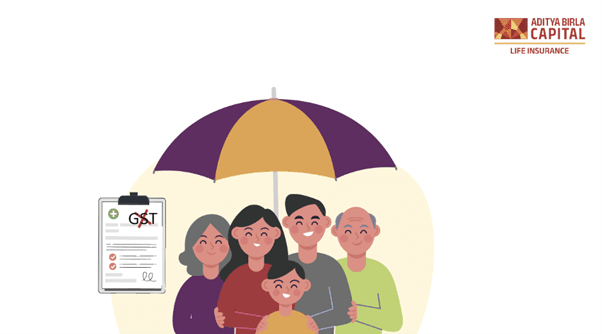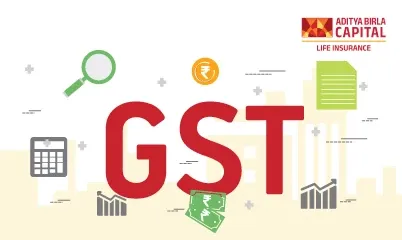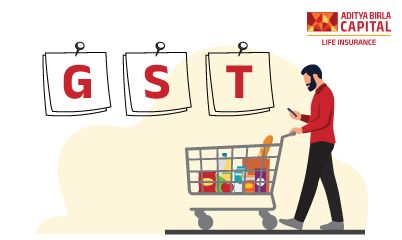For many of us, term insurance is that one financial decision we know we should take, a simple, affordable way to ensure our family’s future stays secure even when life throws unexpected turns. Yet, for years, even the most basic term plans came with an invisible price tag, the 18% GST added on top of every premium.
That changed in September 2025, when the GST Council announced one of the most customer-friendly tax reforms in India’s insurance history.
From 22 September 2025, term insurance plans have become GST-free.
In other words, you now pay 0% GST on your term plan premiums, saving up to 18% instantly without compromising on your life cover.
Let’s understand what this means, how it impacts your existing and future policies, and why this reform could be the turning point for millions of Indian families planning long-term financial security.
What Is a GST-Free Term Insurance Plan?
A GST-free term insurance plan simply means that you are no longer required to pay Goods and Services Tax (GST) on your life insurance premium.
Before this reform, term plans, like most life insurance policies, attracted 18% GST on the entire premium amount. That meant if you were paying ₹10,000 per year, an additional ₹1,800 went straight to tax.
Now, after the GST Council’s 56th meeting, this 18% tax has been completely removed. So your ₹10,000 policy actually costs ₹10,000, not ₹11,800.
This makes term insurance more affordable, accessible, and transparent, especially for young professionals and middle-class families looking to safeguard their loved ones.
Why the GST Council Removed Tax on Term Insurance
The government’s move to remove GST from life and health insurance wasn’t a short-term relief, it was part of a long-term vision to expand financial protection across India.
Here’s what motivated this reform:
1. To Make Financial Protection Affordable
Rising inflation and living costs were making it harder for families to manage long-term commitments like insurance. The government recognised this and decided to reduce the cost burden on essential protection tools.
2. To Boost Insurance Penetration
India’s life insurance penetration remains around 4%, far behind global averages. Removing GST helps bridge that gap by lowering entry costs and encouraging first-time buyers.
3. To Support the “Insurance for All by 2047” Vision
The IRDAI has set a national goal of providing at least one life or health insurance cover for every Indian household by 2047. Zero GST directly supports this mission.
4. To Simplify the Tax Structure
Previously, GST rates and calculations differed across policy types, leading to confusion for customers and compliance complexity for insurers. A 0% rate makes everything simpler and more transparent.
Impact on Term Insurance Premiums
Let’s look at how this change affects the actual amount you pay.
| Sum Assured | Old Annual Premium (with 18% GST) | New Annual Premium (0% GST) | Annual Savings |
|---|
| ₹50 lakh | ₹8,260 | ₹7,000 | ₹1,260 |
| ₹1 crore | ₹11,800 | ₹10,000 | ₹1,800 |
| ₹2 crore | ₹20,060 | ₹17,000 | ₹3,060 |
(Illustrative figures for understanding purposes.)
These savings compound over time. A 30-year-old with a 30-year policy could save nearly ₹54,000 across the policy term, without doing anything differently.
This is why the 2025 GST reform is being called a “silent pay raise” for policyholders.
Who Benefits Most from GST-Free Term Insurance Plans
The reform has a ripple effect across all sections of society, from first-time buyers to existing policyholders.
1. Young Professionals
For those just starting their careers, term insurance is often the first major financial product they buy. The lower premiums make it easier to start early and lock in long-term protection at a young age.
2. Middle-Class Families
Families balancing EMIs, education fees, and daily expenses will find term plans far more affordable. The savings from GST removal can go toward other financial goals like investments or emergency funds.
3. Senior Citizens
For older individuals renewing existing policies or buying new ones, the exemption reduces renewal costs, helping them stay covered without stretching their post-retirement income.
4. Self-Employed Individuals
Without employer-backed insurance, self-employed professionals often rely on personal term covers. The reform gives them significant relief and encourages better financial planning.
How GST-Free Term Plans Help Strengthen Financial Planning
Removing GST does more than just reduce cost, it changes how people approach long-term financial protection.
1. Makes Early Planning Easier
Younger buyers often delay purchasing term plans due to affordability concerns. With reduced premiums, the cost of delaying protection disappears.
2. Improves Household Savings Rate
The extra 18% that previously went to taxes now stays in your savings or can be invested elsewhere, improving your family’s financial health.
3. Enables Higher Coverage
With lower costs, you can upgrade from a ₹50 lakh to a ₹1 crore policy without increasing your annual budget.
4. Encourages Rider Additions
Riders like critical illness, accidental death, or waiver of premium can now be added more easily since these too are GST-free post-reform.
5. Promotes Long-Term Commitment
When premiums feel manageable, policyholders are more likely to renew policies consistently, ensuring uninterrupted coverage.
Impact on Existing Policyholders
If you already have a term insurance plan, here’s how this reform affects you:
-
Lower Renewal Premiums: From your next renewal after 22 September 2025, your insurer will automatically exclude GST from the premium.
-
Same Coverage, Lower Cost: The coverage and benefits remain unchanged, you simply pay less for the same protection.
-
Option to Upgrade: With the reduced premium, you can enhance your sum assured or add riders within the same budget.
-
No Need for Fresh Application: The change applies automatically to all active policies renewed after the effective date.
How the Insurance Industry Benefits
The reform isn’t just a win for customers, it also strengthens the insurance sector in multiple ways.
1. Increase in New Policy Sales
Lower premiums attract more first-time buyers, helping insurers expand their customer base.
2. Reduction in Policy Lapses
Affordable renewals mean more customers will continue paying their premiums regularly, improving retention rates.
3. Simplified Administration
With a uniform 0% GST rate, insurers no longer need to maintain separate tax structures across product types.
4. Strengthened Market Confidence
More people investing in protection translates into higher premium inflows and greater market stability for insurers.
Why This Move Is a Game-Changer for India’s Financial Landscape
Term insurance is one of the simplest and most cost-effective financial tools, and yet, millions of Indians still don’t have it.
By removing GST, the government has addressed one of the biggest barriers to entry: perceived affordability.
This reform has three far-reaching effects:
-
Financial Empowerment: Families can now buy adequate coverage without worrying about taxes inflating the cost.
-
Cultural Shift: Protection becomes a standard household expense, just like rent or school fees.
-
Economic Strength: With more citizens insured, the economy becomes more resilient to shocks such as health crises or job losses.
The GST reform, in this sense, is both an economic and social milestone.
How Much You Can Save Over Time
Let’s take a practical example.
A 30-year-old salaried professional, Ravi, buys a 30-year term plan with a ₹1 crore cover.
Before the reform:
- Base premium: ₹10,000
- GST (18%): ₹1,800
- Total annual premium: ₹11,800
After the reform:
- Base premium: ₹10,000 (No GST)
- Total annual premium: ₹10,000
That’s ₹1,800 saved every year, or ₹54,000 saved over 30 years.
If invested at a modest 7% return, that savings could grow to nearly ₹1.5 lakh, money that stays with Ravi’s family instead of going toward tax.
How GST-Free Term Plans Align with National Goals
This reform supports several national objectives:
-
Financial Inclusion: Making insurance affordable for low- and middle-income households.
-
Digital India: Encouraging online policy purchases through transparent, tax-free pricing.
-
Insurance for All by 2047: Accelerating adoption by removing cost barriers.
-
Economic Stability: Increasing insured population reduces financial vulnerability during crises.
By recognising insurance as an essential service, India has taken a decisive step toward building a financially secure society.
What You Should Do Now
Whether you already have term insurance or are planning to buy one, here’s how you can make the most of this reform.
1. Review Your Current Plan
Check if your policy has been updated with the 0% GST rate. If not, confirm with your insurer before renewal.
2. Increase Your Sum Assured
Use the savings from GST removal to enhance your coverage amount without paying more.
3. Add Riders
You can now add critical illness, waiver of premium, or accidental death riders without worrying about tax-related cost hikes.
4. Buy Early
If you don’t have term insurance yet, this is the perfect time. Lower costs and tax-free premiums make it easier to start.
5. Encourage Family Coverage
Talk to your spouse, parents, or dependents about getting insured. Protection now fits comfortably into most budgets.
A Broader Look: From 18% to 0% – What This Change Represents
| Aspect | Before 22 September 2025 | After 22 September 2025 |
|---|
| GST Rate | 18% | 0% |
| Premium Cost | Higher (included GST) | Reduced |
| Policy Adoption | Moderate | Expected surge in new buyers |
| Accessibility | Limited to upper-income groups | Affordable across all segments |
| Perception | Optional financial tool | Essential family protection |
This transition marks the beginning of a more inclusive, affordable, and responsible insurance culture in India.
How Insurers Like ABSLI Are Supporting This Transition
Insurance providers are already updating systems and processes to reflect the new GST-free structure. This includes:
- Recalculating premiums to exclude tax components
- Updating policy documents with revised rates
- Communicating new benefits to customers through websites, emails, and advisors
- Designing simplified product options for first-time buyers
These steps ensure a smooth transition for both existing and new customers, so that every policyholder can enjoy the benefits of the reform seamlessly.
Why GST-Free Term Insurance Is the Perfect Fit for Modern India
Term insurance has always offered unmatched value:
- High coverage at low cost
- Tax benefits* under Section 80C and 10(10D)**
- Peace of mind for your loved ones
Now, with 0% GST, it becomes an even more powerful tool.
For a generation that values both financial independence and family responsibility, GST-free term insurance offers the best of both worlds, affordability and assurance.
It’s not just about saving tax; it’s about ensuring that every rupee you spend goes toward protecting what matters most.
Final Thoughts
The GST-free term insurance reform is one of the most meaningful financial changes in recent years. By removing the 18% tax burden, the government has turned protection into a right, not a privilege.
For families, it means lighter premiums and greater peace of mind. For insurers, it means a growing and more confident customer base. For the country, it means stronger financial resilience.
If you’ve been waiting for the “right time” to buy term insurance, that time is now.
Because from here on, every rupee you pay secures your family’s tomorrow, not the government’s tax books.










